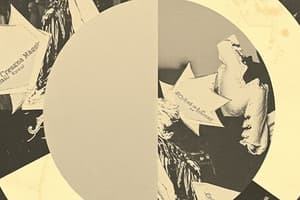Podcast
Questions and Answers
What is the formula to find the circumference of a circle with radius 'r'?
What is the formula to find the circumference of a circle with radius 'r'?
- 2r
- 2πr^2 (correct)
- r^2
- πr
Which of the following is the correct formula for the area of a circle with radius 'r'?
Which of the following is the correct formula for the area of a circle with radius 'r'?
- π(r + r)
- 2πr
- (2/3)πr^3
- πr^2 (correct)
If a circle has a radius of 5 cm, what is its approximate circumference?
If a circle has a radius of 5 cm, what is its approximate circumference?
- 25π cm
- 15 cm
- 31.4 cm
- 10π cm (correct)
If a circle has a diameter of 12 cm, what is its approximate area?
If a circle has a diameter of 12 cm, what is its approximate area?
What is the relationship between the radius and diameter of a circle?
What is the relationship between the radius and diameter of a circle?
Which of the following is not a characteristic measurement of a circle?
Which of the following is not a characteristic measurement of a circle?
What is the relationship between a circle's radius and its diameter?
What is the relationship between a circle's radius and its diameter?
Which line segment in a circle connects two points on the edge of the circle?
Which line segment in a circle connects two points on the edge of the circle?
What is the definition of a circle's diameter?
What is the definition of a circle's diameter?
Which type of chord includes both ends of the line segment while cutting only one minor arc of the circle?
Which type of chord includes both ends of the line segment while cutting only one minor arc of the circle?
How can a central angle be described in relation to a circle?
How can a central angle be described in relation to a circle?
If a circle has a radius of 10 centimeters, what would its diameter be?
If a circle has a radius of 10 centimeters, what would its diameter be?
Flashcards are hidden until you start studying
Study Notes
Introduction
A circle is one of the most fundamental shapes known to us. It's the shape formed by all points equidistant from a common center point. While it may seem simple, there's much more we can learn about this shape beyond its visual appeal. Let's delve into how circles work mathematically, including their measurements like circumference and area, as well as other aspects such as radius, diameter, and chords.
Circumference
The circumference of a circle is the distance around the edge of the circle. It's measured using units like centimeters or inches. In mathematical terms, the formula to find the circumference of a circle with radius 'r' is 2πr. This is the length of the curve you would get if you laid out the curve along a straight line. For example, a circle with a 1-inch radius has a circumference of ( \approx)6.28 inches.
Area
The area of a circle is the region inside the circle. It's usually measured in square units—for instance, square meters or square inches. The formula for finding the area of a circle with radius 'r' is πr^2. If you know any two dimensions of a circle (either the radius or diameter), you can calculate the third.
For instance, if you have a circle with a diameter of 7 inches (which means its radius is half that, or 7/2 = 3.5 inches), you can use that radius value in the above equation to determine that the area of the circle is approximately π(3.5^2), which equals about 19.6 square inches.
Radius
The radius of a circle is simply the distance between the center and any point on the edge or boundary of the circle. A circle's radius is equal to half its diameter; so, for every point on the edge of the circle, the center is exactly halfway between that point and another opposite point on the edge.
Diameter
Diameter refers to the longest possible straight line path through the middle of anything circular. For a circle, this is twice its radius. So, if your circle has a diameter of 42 millimeters, it also has a radius of 21 millimeters.
Chord
In geometry, a chord is any line segment whose endpoints lie on a circle. Chords come in various lengths depending on where they cross the circle. Three types of chords are important; major arcs, central angles, and segments. A major arc includes both ends of the chord while cutting only one minor arc of the smaller circle. Central angles divide the circle into two equal parts and measure in degrees. Lastly, a segment divides the circle into a larger part and a smaller part, with the segment being the shaded portion of the circle.
Studying That Suits You
Use AI to generate personalized quizzes and flashcards to suit your learning preferences.




